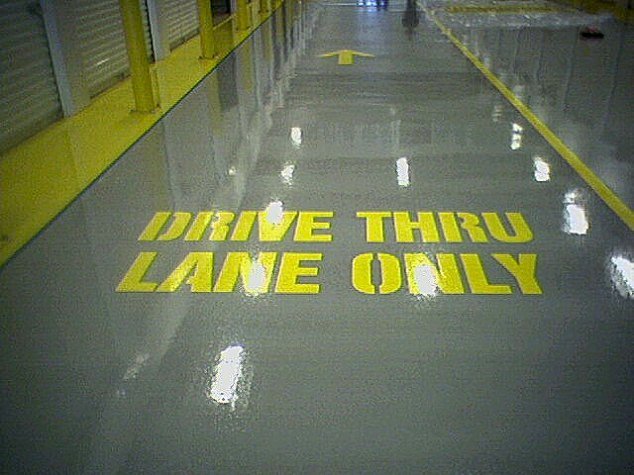
Are you tired of looking at your dull and lifeless concrete surface? Epoxy coatings are here to save the day! Epoxy coatings are a protective layer that is applied to concrete surfaces. They not only enhance the aesthetic appeal of your floors but also provide resistance against stains, chemicals, and abrasions.
In this blog, we will discuss everything you need to know about epoxy coatings. From understanding what they are and their benefits to choosing the right type of epoxy coating for your concrete surface, preparing the concrete surface for application, post-application care and maintenance, and much more. So if you want to protect your concrete surface from wear and tear while giving it a stunning makeover, read on to learn all about epoxy coatings.
Understanding Epoxy Coatings
Epoxy coatings provide a durable surface for concrete floors, creating a high-gloss, seamless finish. These coatings offer protection against stains, grease, and moisture, making them ideal for various applications. With their resistance to abrasion, chemicals, and UV rays, epoxy coatings prove to be a reliable choice. Moreover, they can be applied to both new and existing concrete surfaces, providing homeowners with a versatile and long-lasting flooring option. When considering floor coatings, epoxy is often considered the best garage floor coating due to its durability, affordability, and easy maintenance.
What is Epoxy?
Epoxy is a durable resin coating that forms a strong bond with concrete surfaces. Made of epoxy resin, pigments, and additives, it cures through a chemical reaction, creating a hard and customizable surface. With excellent adhesion, epoxy coatings provide long-lasting protection for your concrete.
Benefits of Epoxy Coatings for Concrete
Epoxy coatings provide numerous benefits for concrete floors. They create a seamless, easy-to-clean surface, making maintenance effortless for homeowners. These coatings are highly resistant to stains, spills, and chemical damage, ensuring the longevity of the floor. They can withstand heavy traffic, making them ideal for high-traffic areas like garages. Additionally, epoxy coatings enhance the appearance of concrete by providing a glossy and professional finish. Overall, they are a durable, affordable, and attractive option for protecting and enhancing concrete surfaces.
How to Choose the Right Epoxy Coating?
Consider the type of substrate, like concrete, when selecting an epoxy coating. Take into account the floor’s traffic and specific needs, such as resistance to chemicals or moisture. Also, consider the desired finish, like gloss or textured. Consult with a professional for the best epoxy coating option.
Factors to Consider when Choosing an Epoxy Coating
When choosing an epoxy coating for your concrete surface, there are several factors to consider. Durability is key, especially if the floor will experience heavy traffic or abrasion. Look for coatings that are resistant to chemical spills, stains, and UV rays for long-lasting protection. Consider maintenance requirements, including cleaning and reapplication. Cost should also be weighed against desired durability and longevity. Consulting with a professional will ensure compatibility with the substrate and specific requirements.
Common Types of Epoxy Coatings
There are several common types of epoxy coatings available for concrete floors. High solids epoxy coatings provide a durable and high gloss finish, enhancing the appearance of the surface. Epoxy paint coatings are a cost-effective option that offer durability and resistance to stains. Specific epoxy concrete floor paints are formulated for concrete surfaces, providing excellent adhesion and moisture resistance. Epoxy primer coatings are used to improve the adhesion and durability of subsequent epoxy coatings. Polyurea coatings, on the other hand, offer fast-curing properties, high abrasion resistance, and chemical resistance.
Preparing Your Concrete for Epoxy Coating
For a successful application of epoxy coatings on concrete, proper surface preparation is crucial. Clean the concrete thoroughly, removing grease, stains, and contaminants. Repair any cracks or damage before applying the coating. Use acid wash or mechanical grinding for optimal adhesion. Ensure proper ventilation for curing. Follow manufacturer’s instructions, including moisture testing, to prepare the surface effectively.
Cleaning and Repairing the Concrete Surface
To prepare your concrete surface for epoxy coating, follow these steps:
- Clean the surface thoroughly using a concrete cleaner to remove grease, stains, and dirt.
- Repair any cracks or damage in the concrete with a patching compound.
- Ensure the surface is completely dry before applying the epoxy coating.
- Remove any existing coatings, paint, or sealers on the concrete for a clean, bare surface.
- Follow the manufacturer’s instructions for proper cleaning and repair techniques to achieve optimal adhesion.
Ensuring Proper Ventilation for Applying Epoxy
Proper ventilation is crucial for successful epoxy coating application. Open windows or use fans to ensure adequate air circulation. Avoid applying in high humidity areas as it affects curing. Follow manufacturer’s guidelines for temperature and humidity, and use personal protective equipment. Consult a professional or epoxy coating supplier for specific ventilation requirements.
Application Process of Epoxy on Concrete
To apply epoxy coatings on concrete, start by preparing the mixture of resin and hardener according to the manufacturer instructions. Thoroughly mix the components to ensure a consistent product. Using a roller, brush, or squeegee, apply the epoxy coating to the concrete surface in small sections, working methodically. If necessary, use a primer to enhance the adhesion of the epoxy coating. Allow the coating to cure, following the recommended time and temperature specified by the manufacturer. If desired, additional coats can be applied, with the waiting time between coats determined by the manufacturer’s recommendations.
Mixing the Epoxy Coating
To achieve the best results with epoxy coatings for concrete, it is important to properly measure and mix the epoxy resin and hardener. Follow the manufacturer’s instructions for the recommended mixing ratios, and be sure to thoroughly blend the components to ensure a consistent finish. You can use a paint mixer attachment or a stir stick to combine the epoxy coating materials. However, be cautious not to over-mix, as this can introduce air bubbles into the mixture. By following these steps, you can ensure a successful application of epoxy floor coating.
Applying the First Layer of Epoxy
To ensure a smooth and durable epoxy floor coating, proper application of the first layer is crucial. Start by preparing the concrete surface, cleaning it thoroughly and etching if necessary. Next, apply an epoxy primer to promote adhesion of the coating. Use a paint roller or brush to evenly distribute the epoxy coating on the floor, working in small sections. Pay attention to edges, corners, and hard-to-reach areas to ensure even coverage. By following these steps, you can achieve a professional-looking and long-lasting floor coating.
Second Coat Application and Drying Time
To ensure a successful application of epoxy coatings for concrete, it is important to follow the proper process. After allowing the first coat to cure according to the manufacturer’s instructions, apply the second coat using the same method. Be sure to allow for sufficient drying time between coats to prevent issues such as peeling or poor adhesion. It is also crucial to adhere to recommended temperature and humidity guidelines for optimal drying. During the curing process, avoid heavy traffic and moisture exposure.
Post Application Care and Maintenance of Epoxy Coating
To preserve the quality and longevity of epoxy coatings, proper care and maintenance are necessary. Avoid heavy or sharp objects that can scratch or damage the surface. Regularly sweep or vacuum to remove dirt and debris. Clean spills promptly to prevent stains or chemical damage. Use mild, non-abrasive cleaning agents and avoid harsh chemicals or solvents. Applying a high-quality epoxy floor finish or wax can enhance gloss and extend coating life.
Ensuring Longevity of Your Epoxy Coating
To prolong the life of your epoxy coating, take these measures: use floor mats in high traffic areas, avoid dragging heavy furniture, appliances, or equipment across the floor, use floor protectors on furniture legs, regularly inspect for damage or wear, and schedule periodic maintenance like recoating.
Repairing Damaged Epoxy Coating
To repair damaged epoxy coating, first assess the extent of the damage. Clean and prep the area by removing loose or peeling coating. Apply epoxy resin or concrete floor paint as instructed by the manufacturer. Smooth and blend the repair with the surrounding coating for a seamless finish. Allow proper curing time before using the floor again.
Is Epoxy Coating the Best Option for Your Concrete Surface?
Factors to determine if epoxy coating is ideal for your concrete surface include substrate type, durability, chemical and abrasion resistance, traffic and moisture levels, and exposure to UV rays. Compare different epoxy coating options and consult professionals for the best system for your specific needs.
Conclusion
In conclusion, epoxy coatings provide a durable and long-lasting solution to protect your concrete surfaces. With their numerous benefits such as resistance to chemicals, abrasion, and moisture, epoxy coatings can significantly extend the lifespan of your concrete. It is important to choose the right epoxy coating based on factors like the type of concrete surface and the intended use. Proper preparation of the concrete surface is crucial for the successful application of epoxy coatings. Additionally, regular maintenance and repairs are necessary to ensure the longevity of the epoxy coating. If you have any questions or need assistance in choosing the right epoxy coating for your concrete, feel free to get in touch with our experts.
